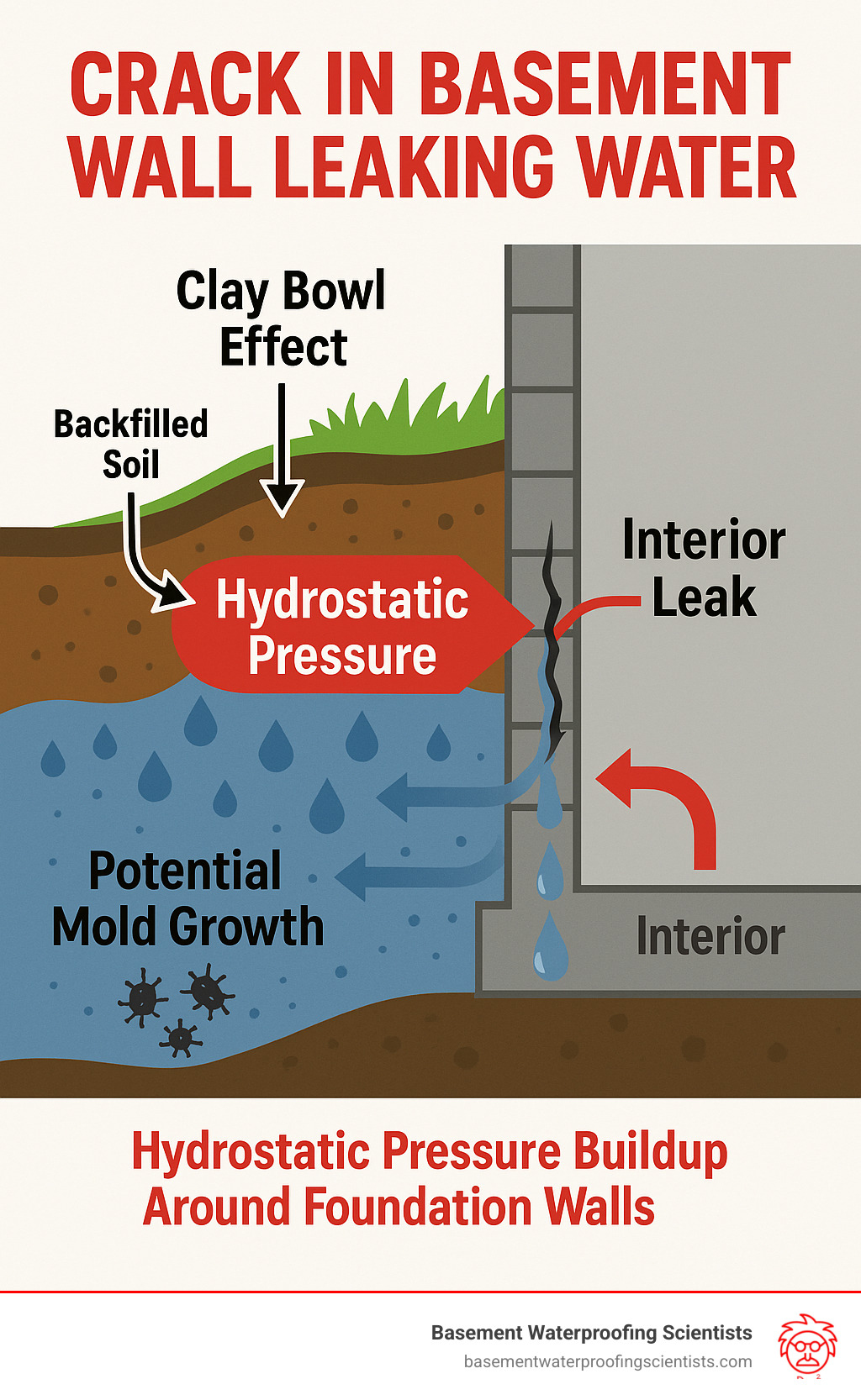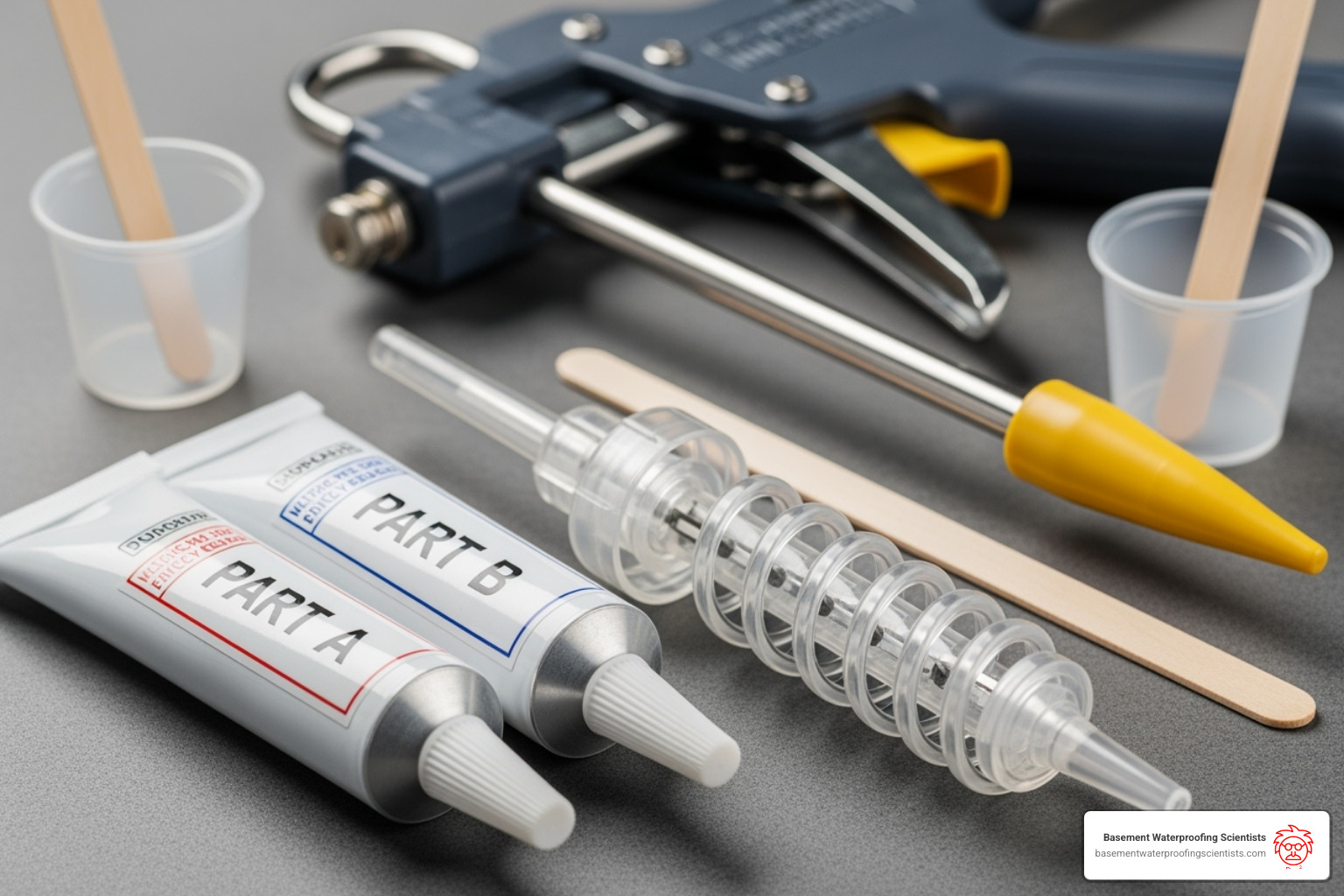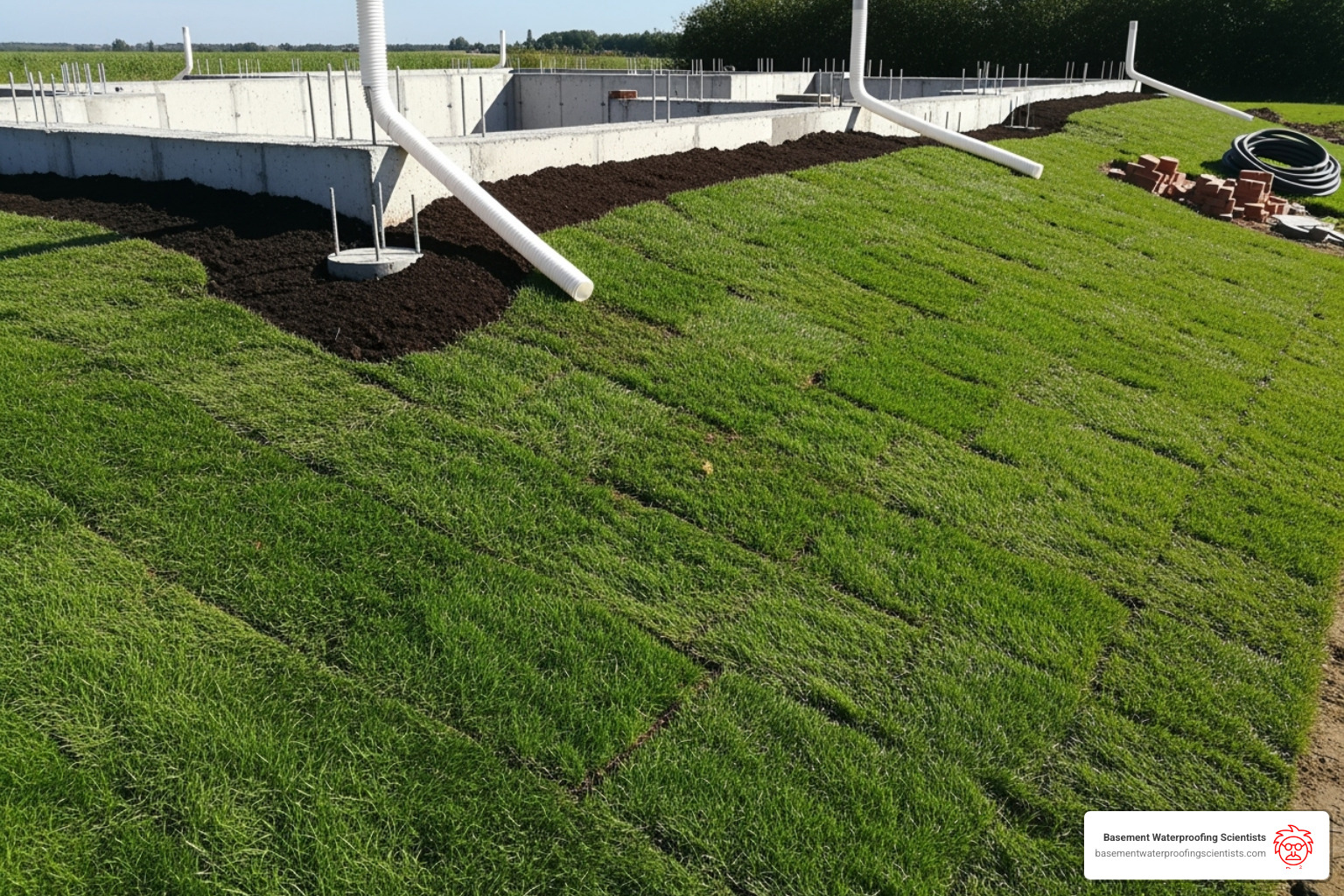Why That Crack in Basement Wall Leaking Water Is More Than Just an Eyesore
A crack in basement wall leaking water is a sign of a bigger problem. That leak is likely caused by hydrostatic pressure—immense force from water-saturated soil pushing against your foundation. This pressure is often worsened by the “clay bowl effect,” where loose backfill soil around your home traps water, creating a pressure cooker against your basement walls.
If you see a leak, your first steps are to remove any standing water to prevent mold, document the crack, and check your home’s exterior gutters and grading. While temporary sealants might seem like a quick fix, they often fail within months. A permanent solution requires a professional approach, like injection repair or exterior waterproofing, to address the underlying pressure.
I’m Darin Garvey, and for over 30 years, my team at Basement Waterproofing Scientists has provided Philadelphia-area homeowners with permanent solutions for their leaking basements. We’ll help you understand the problem and fix it for good.

Find more about crack in basement wall leaking water:
Why You Have a Crack in Basement Wall Leaking Water
Your basement is under constant attack from unseen forces. The main culprit behind a crack in basement wall leaking water is hydrostatic pressure. When rain or snowmelt saturates the soil around your foundation, the weight of that water exerts incredible force on your walls, pushing moisture through any available weak spot.
This is often made worse by the clay bowl effect, where the disturbed soil used to backfill your foundation traps water like a basin, intensifying the pressure. Other common causes include:
- Concrete Shrinkage: As new concrete cures, it naturally shrinks, creating small vertical cracks that become pathways for water.
- Foundation Settlement: All houses settle, but uneven (differential) settlement creates stress fractures, which can appear as more serious horizontal or stair-step cracks.
- Freeze-Thaw Cycles: Water in small cracks freezes and expands, acting like a wedge that widens the crack over time, turning minor issues into major leaks.
Understanding the Signs and Symptoms
Your basement sends warning signals before a major flood. Look for these signs to catch problems early:
- Water Stains: Discolored patches on walls or floors show where water has previously entered.
- Puddles on the Floor: The most obvious sign of an active leak, typically appearing after storms.
- Peeling Paint or Wallpaper: Moisture behind wall coverings causes them to bubble and peel.
- Musty Smell: A damp, earthy odor indicates mold or mildew is growing, which can happen in just 24-48 hours after water intrusion.
- Visible Mold: Black, green, or white fuzzy spots are a serious health concern requiring immediate action.
- Efflorescence: A white, chalky powder on concrete, which is mineral deposits left behind as water evaporates from the wall.
Structural vs. Non-Structural Cracks: What’s the Difference?
Knowing the type of crack helps determine the urgency of the repair.

Non-structural cracks (or “waterproofing cracks”) are common and don’t threaten your home’s stability, but they do let in water. These are typically vertical or hairline cracks caused by concrete shrinkage.
Structural cracks indicate a serious problem with your foundation’s stability. Be on high alert for:
- Horizontal cracks: Almost always a sign of extreme soil pressure causing the wall to fail or bow.
- Stair-step cracks: Common in block foundations, they signal uneven foundation settlement.
- Wide cracks: As a rule of thumb, if a crack is wider than 1/4 inch, it should be considered structural and requires immediate professional evaluation.
Any crack in basement wall leaking water needs attention, but structural cracks are an emergency that threatens your home’s safety.
For more detailed information about exterior foundation cracks, check out our comprehensive guide.
How to Fix a Leaking Basement Wall Crack
Once you’ve identified the crack in basement wall leaking water, the next step is choosing the right repair. The best method depends on the crack type and whether it’s best accessed from inside or outside.
Professional repair methods are far more effective than simple patches. Epoxy injection structurally bonds the concrete back together, making it ideal for stable cracks. For active leaks, polyurethane foam injection is superior. It expands on contact with water to fill the entire void and remains flexible, accommodating minor foundation movements over time. For emergencies, hydraulic cement can be used to quickly stop flowing water before a permanent repair is made.

Repairing Cracks from the Inside vs. the Outside
Deciding whether to repair from the interior or exterior depends on your foundation, budget, and accessibility.
Interior repairs are less invasive, more affordable, and can be done year-round, making them the top choice for poured concrete foundations. However, they don’t address the external water pressure. Exterior repairs tackle the problem at the source and are ideal for block foundations or when interior walls are finished, but they require costly and disruptive excavation.
| Feature | Interior Crack Repair | Exterior Crack Repair |
|---|---|---|
| Pros | – Less invasive (no digging up yard) | – Addresses the problem at the source (outside wall) |
| – Often faster and cheaper | – Ideal for block or stone foundations | |
| – Can be done year-round | – Good for cracks behind finished walls (no interior demo) | |
| – Effective for poured concrete foundations | – Protects the entire wall from water penetration | |
| Cons | – Doesn’t address external hydrostatic pressure | – More expensive (can be 3x or more than interior) |
| – Requires access to the crack from inside | – Highly invasive (requires excavation) | |
| – Less effective for block/stone foundations | – Dependent on weather conditions | |
| – May not prevent future cracks nearby | – Disrupts landscaping | |
| Best For | – Poured concrete walls | – Cinder block or fieldstone foundations |
| – Simple, non-structural, active leaks | – Cracks behind finished basements (to avoid demo) | |
| – Cost-conscious homeowners | – Addressing widespread exterior water issues |
Learn how to seal exterior foundation cracks for situations where exterior repair makes the most sense.
A Step-by-Step Guide to Interior Crack Injection
Professional interior injection is a precise process that permanently seals a crack in basement wall leaking water.
- Preparation: The crack is thoroughly cleaned of loose debris and old paint to ensure a strong bond.
- Port Installation: Small injection ports are installed along the length of the crack to serve as entry points for the sealant.
- Surface Sealing: A temporary seal of epoxy paste is applied over the crack’s surface to ensure the injection material is forced deep inside the wall, not out onto the floor.
- Injection: Polyurethane foam or epoxy is injected under pressure into the lowest port, filling the crack from the bottom up until the entire void is saturated.
- Curing: The material cures over several hours or days, creating a permanent, waterproof barrier. The ports are then removed and the surface is cleaned up.
For more detailed information on basement crack sealers, our comprehensive guide covers everything you need to know about materials and methods.
Long-Term Prevention: How to Stop Future Leaks
Fixing the current crack in basement wall leaking water is only half the battle. True victory comes from managing water around your home to prevent future leaks. The goal is to control water before it can build up hydrostatic pressure against your foundation.

The Critical Role of Gutters and Grading
Most basement water problems start at the roofline. Effective water management is your first line of defense.
- Clean Your Gutters: Clogged gutters cause rainwater to overflow and saturate the ground right next to your foundation.
- Extend Your Downspouts: Ensure downspouts discharge water at least 10 feet away from your house. This simple step prevents thousands of gallons of water from pooling against your walls.
- Check Your Yard Grading: The ground around your foundation should slope away from the house—ideally, at least one inch per foot for the first 6-10 feet. This encourages water to flow away naturally instead of collecting against the foundation.
Want to dive deeper? Check out our guide on how to waterproof your basement.
When to Consider an Interior Drainage System
Sometimes, good grading and gutters aren’t enough, especially in areas with high water tables or heavy clay soil. If you experience recurring leaks, widespread dampness, or water entering at the cove joint (where the wall meets the floor), it’s time for a more robust solution.
An interior drainage system is the ultimate defense. It works by collecting water that enters the basement and actively pumping it out.
- Drain Tile: A perforated pipe is installed in a trench along the inside perimeter of your basement floor. It intercepts water that seeps in through the walls or up from the ground.
- Sump Pump: The drain tile channels water to a sump pit, where a sump pump automatically activates to discharge the water safely away from your home. A battery backup is essential for protection during power outages.
This system doesn’t fight hydrostatic pressure; it relieves it by giving water a controlled path out of your basement. While a full system is an investment (typically $4K-$8K), it provides a permanent solution and a lifetime of peace of mind.
When to Call a Professional for a Crack in Basement Wall Leaking Water
While DIY fixes are tempting, a crack in basement wall leaking water often requires an expert to ensure a permanent solution. Knowing when to call a professional can save you from costly, repeated repairs and bigger problems down the line.

Identifying Cracks That Demand Expert Attention
Certain cracks are red flags for serious structural issues. Call a professional immediately if you see:
- Horizontal Cracks or Bowing Walls: These are signs of extreme soil pressure compromising your foundation’s integrity. This is a structural emergency.
- Cracks Wider Than 1/4 Inch: A crack you can fit a quarter into has moved beyond a simple shrinkage issue and points to significant foundation movement.
- Recurring Water Intrusion: If you’ve patched a leak and it keeps returning, it means the underlying cause hasn’t been addressed. Professionals have the tools to find the true entry point.
- Multiple Leaks: Water appearing in several spots suggests a widespread water management problem that requires a comprehensive solution, not just a spot repair.
Find out who to call for water in your basement when you’re not sure where to start.
The Consequences of Ignoring the Problem
Ignoring a leaking crack will only make the problem worse. The potential consequences are severe:
- Escalating Structural Damage: Water erodes the soil supporting your foundation, leading to more settlement and bigger cracks. A small repair can turn into a major structural project.
- Serious Health Risks: Mold can grow within 24-48 hours, releasing spores into your home’s air that can trigger allergies and respiratory problems.
- Pest Infestations: Damp basements are an open invitation for insects and rodents.
- Decreased Property Value: A wet basement is a major red flag for potential home buyers and can significantly lower your home’s value.
- Higher Future Costs: The longer you wait, the more extensive and expensive the repairs become. A crack injection that costs hundreds today could become a full waterproofing system costing thousands tomorrow.
Learn about leaking basement wall repair costs so you know what to expect. That crack in basement wall leaking water won’t fix itself, but with professional help, you can protect your home and your investment.
Frequently Asked Questions about Leaking Basement Cracks
As a waterproofing expert with 30 years of experience, I’ve answered thousands of questions about a crack in basement wall leaking water. Here are the most common ones.
Can I just paint over a leaking crack?
No. Paint cannot withstand hydrostatic pressure and will quickly bubble and peel as water pushes through. Worse, it traps moisture inside the wall, creating a perfect environment for mold to grow unseen between the paint and the concrete. A proper injection seal is the only way to permanently stop the leak.
How much does it cost to fix a leaking basement wall crack?
Costs vary based on the method. DIY kits cost $75-$200 but are often temporary fixes. Professional injection repair with epoxy or polyurethane typically runs from $400 to $1,000 per crack but comes with a permanent, warrantied solution. For widespread issues, a full interior drainage system averages $4,000 to $8,000 and provides a lifetime of protection for your entire basement.
Is a vertical crack in a basement wall serious?
Generally, vertical cracks are the least serious type, often caused by normal concrete shrinkage. They are not usually a structural threat. However, if a crack in basement wall leaking water—even a vertical one—it still needs to be sealed to prevent water damage, mold, and pests. You should become concerned if a vertical crack is wider than a quarter-inch or is actively growing, as this could indicate a more serious settlement issue that requires a professional evaluation.
Secure Your Foundation and Your Peace of Mind
A crack in basement wall leaking water is a solvable problem. With the right expertise, you can stop the leak permanently and regain the peace of mind that comes with knowing your home is safe and dry. Fixing a leak isn’t just about patching a crack; it’s about protecting your investment and ensuring a healthy environment for your family.
At Basement Waterproofing Scientists, we get to the root cause of the problem. We use specialized equipment to identify the true source of the leak, allowing us to provide targeted, effective repairs that often cost less than you’d expect. We offer customized solutions, from crack injections to full interior drainage systems (averaging $4,000-$8,000 for complete basement waterproofing), all backed by our lifetime guarantee.
Don’t let a leaking basement threaten your home’s value and structural integrity. We proudly serve homeowners throughout Philadelphia, Reading, Norristown, Pottstown, Bensalem Township, Upper Darby Township, Bristol Township, Middletown Township, Lansdale, Warminster Township, Springfield Township, Haverford Township, Radnor Township, Willow Grove, King of Prussia, Horsham, Exeter Township, Cumru Township, Ardmore, Bryn Mawr, Quakertown, Royersford, Conshohocken, Hatboro, Collegeville, Pennsylvania, New Jersey, and Delaware.
Ready to reclaim your dry basement? Schedule your professional inspection for basement wall crack repair today! Your future self will thank you for taking this step toward a permanently dry, healthy home.

